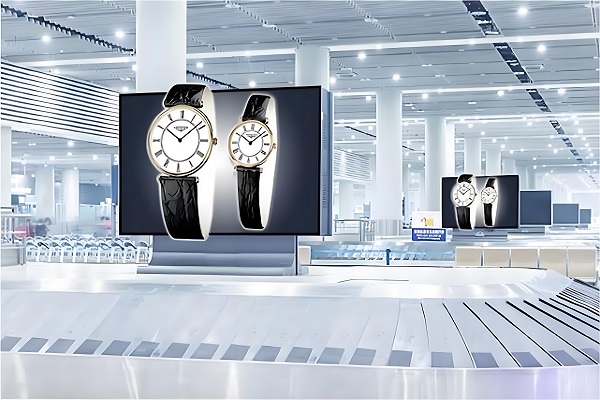The 3D giant screen has redefined urban visual storytelling, merging cutting-edge technology with artistic creativity to deliver immersive experiences without the need for glasses. Leveraging innovations like parallax barriers, ultra-high resolutions, and real-time interactivity, these screens captivate audiences globally while driving commercial and cultural value. Below, we explore iconic installations and their transformative impacts.
Technological Foundations of 3D Giant Screens
1. Parallax Barrier and Lenticular Lens Systems
Modern naked-eye 3D giant screens rely on parallax barriers or lenticular lenses to direct light at precise angles, creating depth perception. For example, screens with horizontal viewing angles exceeding 120°ensure clarity for large crowds, while pixel densities ≤2mm minimize visual artifacts. Advanced systems achieve refresh rates up to 3840Hz, eliminating flicker even in high-motion content.
2. High-Brightness LED Modules
Outdoor installations demand LEDs with 6,000–8,000 nits brightness to counteract sunlight glare. Coupled with 8K–12K resolutions, these modules render hyper-detailed visuals. Beijing’s Wangfujing Department Store screen, for instance, operates at 7,500 nits and a 480Hz refresh rate, ensuring seamless animations for its 1,200m² display.
3. Hybrid Integration with AR and AI
To enhance interactivity, many 3D giant screens integrate augmented reality (AR) overlays and AI-driven content. For example, Beijing’s 2024 Spring Festival displays combined 5G networks with AR to project virtual fireworks, while AI algorithms adapted visuals in real time based on crowd density.

Global Showcases of 3D Giant Screens
1. COEX Wave, Seoul, South Korea
Seoul’s COEX Wave features a 30m-wide curved 3D giant screen with 8K resolution. Its AI-powered content adapts to real-time crowd movements, achieving a latency of <20ms. Installed in 2022, it attracts 3 million annual visitors and boosts retail revenue by 18% through dynamic advertisements and cultural showcases.
2. Pavilion Kuala Lumpur, Malaysia
Malaysia’s Pavilion Mall houses a 25m-tall cylindrical 3D giant screen with a 360° viewing range. Utilizing 4.8 million micro-LEDs (pixel pitch: 3mm), it projects hyper-realistic animations synchronized to 128-channel spatial audio. This installation increased foot traffic by 25% during peak hours, becoming a landmark for luxury brand campaigns.
3. Wangfujing Department Store, Beijing, China
Beijing’s iconic shopping district features a 1,200m² 3D giant screen renowned for its dual-layer LED panels and holographic effects. During the 2024 Spring Festival, it showcased playful animations of pandas and dinosaurs, attracting over 500,000 daily viewers. Operating at 7,500 nits brightness, the screen achieves 0.1ms response times, elevating ad engagement by 40% for brands like Louis Vuitton and Gucci.
4. Jiefangbei Commercial Tower, Chongqing, China
Chongqing’s landmark 3D giant screen spans 1,800m² with a concave design and 12K resolution. Its hybrid lenticular-parallax system supports 16-bit color depth, enabling 4D effects like simulated rain and wind. Post-installation, tourist visits surged by 35%, while energy consumption dropped by 30% through modular power management.
Economic and Cultural Impacts of 3D Giant Screens
1. Boosting Urban Revitalization
These screens act as economic catalysts. Seoul’s COEX Wave generated $12M in advertising revenue within its first year, while Beijing’s Wangfujing screen increased retail sales by 22% during holiday seasons.
2. Cultural Storytelling and Sustainability
Beyond commerce, 3D giant screens celebrate cultural heritage. Beijing’s Spring Festival displays fused traditional elements (e.g., dragon motifs) with AR-powered electronic fireworks, reducing environmental impact compared to pyrotechnics. Similarly, Chongqing’s screen integrates local river landscapes into its 4D content, promoting regional tourism.
3. Technological Synergy
Cities like Kuala Lumpur and Chongqing now pair 3D giant screens with smart city infrastructure. For example, Pavilion Kuala Lumpur’s screen uses IoT sensors to adjust brightness based on ambient light, cutting energy use by 25%.
In conclusion, the 3D giant screen represents a fusion of art, technology, and commerce, transforming urban spaces into dynamic canvases. From Seoul’s AI-powered curves to Beijing’s festive holograms, these installations exemplify how innovation can elevate public engagement while driving sustainable growth. As cities worldwide embrace this medium, the future of urban storytelling shines brighter than ever.





